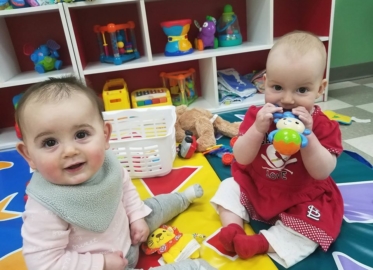At ALC we take pride in helping our students develop a life long love of learning. This isn’t just an abstract concept that we toss about lightly. The teachers at Adventure Learning Center spend hours each week weaving reading, science and art into cohesive lesson plans that are as educational as they are fun. In many cases our teachers are able to work in complex theories into engaging activities that the kids love. One way they do so is by creating cool science activities for preschoolers like the one our Pre-school 2 class completed last week. For a week that focused on the letter R, the classroom read the book “A Rainbow of My Own,” by Don Freeman. In addition to some fun, rainbow art projects the classroom also learned about the scientific theory of capillary action. This is a fairly complicated scientific theory, but with the use of an engaging experiment we were able to teach four-year-olds using tools you may have at home.
Science Activities for Preschoolers
In order to understand how this experiment worked, let us give you a brief primer on capillary action. The concept of capillary action is fairly simple. Also called wicking, it is the ability of a liquid to flow into a space with out the assistance (and sometimes in opposition to) external forces such as gravity. This affect can be simply shown by the ability of a paint brush to draw up paint into the hairs of the brush or when tea creeps up the string on a tea bag, despite gravity. The concept is helpful to understanding how tree roots draw water from the ground.
In the preschool 2 classroom we used seven glasses of water, paper towels and food coloring to illustrate this science activity for our preschoolers.

The starting point for the experiment.
We started off with alternating primary colors and plain water in clear plastic cup. To create a rainbow we filled our color cups with red, yellow, blue and pink respectively. As a class, we hypothesized what color combinations may come from our experiment.

Step two is to add paper towels to act as wicks or capillaries for the water.
To create the capillary effect we used absorbent paper towels and folded them to make a bridge between two cups. Half of the paper towel is placed into a colored cup, the other half in a clear water cup. With the exception of the first and last cups, each cup contained two ends of the paper towels, making a rainbow bridge across the cups. And then, we waited. The kids were anxious to see a change in the experiment so we had to remind them that sometimes science takes time.

After several hours we were able to see how capillary action was starting to change the colors in our cups!
It took a little time, but slowly the paper towel were able to wick the respective colors from one cup and deposit it into the next. Because we linked multiple colors together, we were also able to show our students the properties of color blending. We were able to show them that yellow and red made orange, while yellow and blue made green and so on.

With a little patience, we were able to make rainbows of our own!
This lesson was a great way to tie together our reading comprehension, our art projects and a science experiment for our students. Not only did it teach a great lesson in a complex scientific theory, but it also taught a great lessons in patience. This project took quite some time to complete and the children were able to watch as the colored water slowly wicked its way from cup to cup. Tracking the project over the course of the day helped to keep the entire classroom engaged in the core lesson concepts all day long.
This is a great project to try at home as well. With a few as three cups, a couple of paper towels, food coloring and a little time, you can illustrate some of the colorfully beautiful concepts that science can offer your child.

